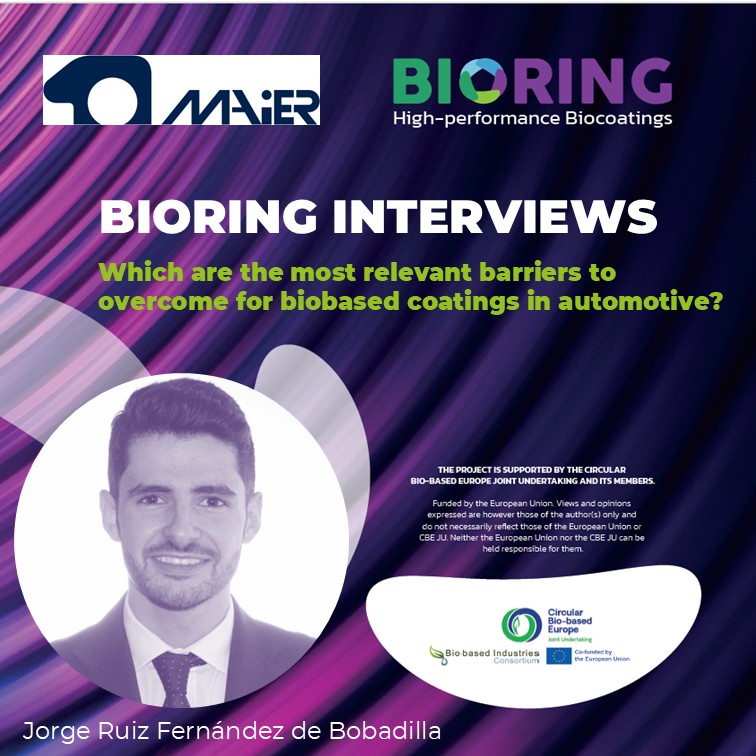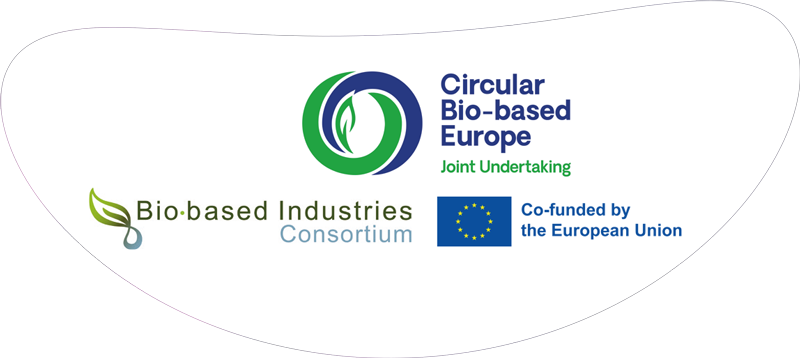Are bio-based solutions a “good coating” for automotive? Balancing aesthetic, protection, and sustainability
Interview to Jorge Ruiz Fernández de Bobadilla, MAIER Technology Centre and BIORING partner
(Tnterview made on 4th November 2024)
Which is the novelty and added value of the BIORING process and product solutions?
The product developed in BIORING is a really high percentage (up to 95%) of bio-based content UV-curing coating targeting different sectors, with automotive as one of them. The main novelty is precisely the percentage, since UV curable bio-based coatings now in the market usually have low percentage of bio content, around 30% in best cases.
Another improvement we are aiming at concerns bio-coatings applications. Usually they are applied to wood – or, more generally, interior – furniture. BIORING novelty in what concerns to automotive sector is to develop a bio coating for plastic substrates, also able to resist the particularly hard automotive resistance tests, whether for interior or exterior parts.
All of this, while facilitating the reduction of non-renewable fossil fuels consumption in coatings manufacture combined with the UV curing technology.
Which are the most relevant barriers to overcome for biobased coatings in automotive?
This is one of the main topics we at BIORING are dealing with. In recent years, to compete with their petrochemical-based analogues multiple companies have developed biobased coatings, including thermally-cured ones for plastic parts in the automotive sector. Plastic coatings are in fact increasingly demanded, since lightweight plastic is replacing heavy components like iron: the automotive sector covers about 35% of this market (in 2019).
However, there are several hurdles to be overcome by this sector before it can compete with fossil-based state-of-the-art. One of the most relevant is cost: bio-based coatings undergo a complex process to be environment friendly, increasing their final cost compared to petrochemical alternatives.
This leads to a terminology, and marketing, issue. Try to balance cost and market attractiveness is the reason why some coatings formulations labelled as “bio” actually present on the market are not so much bio-based: they include some bio-based raw materials, yes, but a great part of the “bio” or “sustainable” can come from the sustainable technologies applied (e.g. use of renewable energy) or by counting an increased percentage of water (e.g. switching entirely to water-based products). It’s a tricky topic, and research is still ongoing, thus what really “sustainable” or “bio-based” mean is still to clarify, and it does not involve only aspects linked to the preparation of a chemical.
If we talk about the UV-curable versions of plastic coatings with high percentage of bio-based raw material, that’s what BIORING aims at, and the barriers are:
- The compatibility with injection moulded thermoplastic substrates, and the needed rheology for aerographic process;
- The hard automotive resistance tests that the coating need to pass, either for exterior or interior parts;
- The possible economic disadvantage of development/production compared to fossil-based ones.
Which are the most relevant parameters & requirements to compare fossil-based and bio-based coatings in the automotive sector, looking at BIORING as well as benchmarks on the market?
Automotive coatings play a critical role in the protection and aesthetics of vehicles: a good coating enhances the appearance of a vehicle, while also providing a protective barrier against environmental factors like UV rays, moisture, and chemicals.
Automotive requirements are specifically designed according to the position the part occupies in the vehicle and are determined by the behaviour of the coated parts in different mechanical, thermal, chemical, humidity, UV light aging and aesthetic appearance tests.
The aim of these tests is to evaluate the parts for accelerated ageing, which represents in a shorter time what happens to the parts during their total lifetime in the vehicle, ensuring that their aesthetic and functional properties are maintained.
These requirements depend strongly on the covering coating/varnish properties, whose function is to protect the inner decoration layers or the injection moulded part.
Although each part has its own tests depending on car position, the main distinction in test type and requirements is whether the part is for the exterior or interior of the vehicle.
In what concerns to comparing fossil and bio-based coatings, including BIORING’s solution, applied over injection moulded thermoplastic samples or parts by an aerographic and UV-curing process, we taken into account the following topics:
- Viscosity for the aerographic process
- Adhesion to plastic substrates
- Chemical resistance
- Abrasion resistance
- Scratch resistance
- Thermal tests
- UV Light resistance (Accelerated aging)
- Cost of the coating
The challenge is hard, because the traditional coating types on the market offer a wide range of high-quality and cost-competitive alternatives, that we at BIOIRNG mapped:
- Polyurethane coatings, one of the most widely used, durable, with excellent resistance against UV rays and weathering, and available in various colours: an ideal choice for car body painting.
- Epoxy coatings, highly chemical resistant and durable, often used for un-decorating, primer before painting, and to repair and restore damaged car parts.
- Acrylic coatings, a popular choice for car refinishing due to their quick drying time and ease of application, also known for their high gloss and colour retention properties.
- Ceramic coatings, a newer type of automotive coating that gained popularity in recent years, with excellent protection against scratches, chemicals, and UV rays, and that can last for several years without needing reapplication.
What do you like the most and what are your expectations in participating to the BIORING project?
The most exiting aspect is being able to participate and collaborate in the development of a novelty product which can satisfy to our OEM (Original Equipment Manufacturer) requirements, contributing to the sustainability of automotive sector. We are preparing for (near) future demands and requirements of the whole coating sector, in the line with the BIORING objectives.
About
I work as R&D engineer since 2022 inside decoration technologies segment, and I have been involved in some projects related to different ranges of aerographic fossil-based coatings on different plastics substrates, targeting automotive exterior parts with different decorative and functional properties.
My experience is in MAIER, a plastic parts decorator and manufacturer of complex injection mouldings for the automotive industry. Within BIORING, the role of MAIER is to establish the coatings requirements for the automotive case study, apply samples in plastic parts to find the processing window, and test the coated parts to check the fulfilment of automotive requirements.


